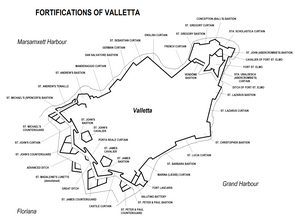
Back Vallettas forsvarsværker Danish Fortificaciones de La Valeta Spanish Mura della Valletta Italian Fortyfikacje Valletty Polish Fortifikacije v Valletti Slovenian 瓦莱塔防御工事 Chinese
| Fortifications of Valletta | |
|---|---|
Is-Swar tal-Belt Valletta | |
| Valletta, Malta | |
 Valletta Land Front as seen from Manoel Island | |
 Map of Valletta's fortifications | |
| Coordinates | 35°53′50″N 14°30′31.5″E / 35.89722°N 14.508750°E |
| Type | City wall |
| Site information | |
| Owner | Government of Malta |
| Open to the public | Yes |
| Condition | Mostly intact |
| Site history | |
| Built | 1566–1570s[a] |
| Built by | Order of Saint John British Empire (some modifications) |
| In use | 1571–1970s |
| Materials | Limestone |
| Battles/wars | French invasion of Malta (1798) Siege of Malta (1798–1800) World War II |
| Events | Rising of the Priests |
| Type | Cultural |
| Criteria | i, vi |
| Designated | 1980 (4th session) |
| Part of | City of Valletta |
| Reference no. | 131 |
| Region | Europe and North America |
The fortifications of Valletta (Maltese: Is-Swar tal-Belt Valletta) are a series of defensive walls and other fortifications which surround Valletta, the capital city of Malta. The first fortification to be built was Fort Saint Elmo in 1552, but the fortifications of the city proper began to be built in 1566 when it was founded by Grand Master Jean de Valette. Modifications were made throughout the following centuries, with the last major addition being Fort Lascaris which was completed in 1856. Most of the fortifications remain largely intact today.
The city of Valletta, along with Nicosia in Cyprus, was considered to be a practical example of an ideal city of the Renaissance, and this was due to its fortifications as well as the urban life within the city.[1] The fortifications were well known throughout Europe by the 17th century, and might have influenced the designs of part of the Fortress of Luxembourg.[2] In an 1878 book, Valletta was described as "one of the best fortified [cities] in the world."[3] Valletta's fortifications are the most important of the fortifications of Malta,[4] and today they form part of a UNESCO World Heritage Site.[5]
Cite error: There are <ref group=lower-alpha> tags or {{efn}} templates on this page, but the references will not show without a {{reflist|group=lower-alpha}} template or {{notelist}} template (see the help page).
- ^ Cosmescu, Dragos. "Nicosia". fortified-places.com. Archived from the original on 10 August 2017.
- ^ "Luxembourg". fortified-places.com. Archived from the original on 22 February 2015.
- ^ Pembroke Fetridge, William (1874). The American Travellers' Guides: Hand-books for Travellers in Europe and the East, Being a Guide Through Great Britain and Ireland, France, Belgium, Holland, Germany, Austria, Italy, Egypt, Syria, Turkey, Greece, Switzerland, Tyrol, Denmark, Norway, Sweden, Russia, Spain, and Portugal. Fetridge & Company. p. 517.
- ^ "Malta restores her historic fortifications". Arx – International Journal of Military Architecture and Fortification. 8: 7. July 2011. Retrieved 16 August 2015.
- ^ "City of Valletta". UNESCO World Heritage List. Archived from the original on 8 February 2016.
© MMXXIII Rich X Search. We shall prevail. All rights reserved. Rich X Search
